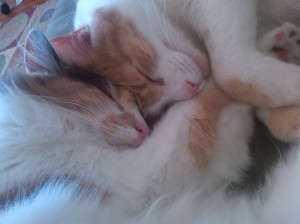My first job after college was at a health insurance company, making copies, printing out letters to reject claim appeals, filing, sending out mailings, and answering phones…and those were the fun parts. For this position, across from Westlake Park in downtown Seattle, I’d turned down an offer for the proofreading night shift at a tiny publisher situated in a bad part of town and a position assisting a quadriplegic entrepreneur, which sounded fascinating until every last member of his staff made a point of telling me he regularly insulted them until they cried.
By the time I capitulated and took the health insurance job, I was feeling the strain of hunching over a computer on a flea-infested rug in an apartment without furniture (yes, in the same building where I was later threatened by a shotgun-wielding retiree), living in a city where I knew no one and couldn’t afford to go out. I took a part-time telemarketing gig that involved calling up unemployed people without health insurance and trying to get them to buy season theater tickets. A bubbly blonde actress who started the same night I did almost immediately started reeling in customers, while I rapidly proved myself to be the world’s worst telemarketer. I didn’t even make it through the training, and after two nights on the phone I stopped coming, too humiliated to ask if I would have a paycheck.
I did not have much more aptitude for clerical work than I did for telemarketing. I learned that my high GPA and undergraduate degree did not necessarily mean I could survive in an office without losing my mind. I thought health insurance was ethically wrong – insurance companies profited from people’s vulnerabilities and fears, weaseled out of paying for illnesses, and had an entire department of registered nurses and doctors whose sole purpose was to ensure that treatments were medically necessary, which turned out to be code for finding reasons to deny coverage – but by then I needed the money.
Essentially, my first lesson after graduation was one that most people grow up knowing: idealism is hard to maintain when you need to pay the rent. Though I looked down on my coworkers for their unquestioning loyalty to a company that made its money through the pain and suffering of its customers, I quickly realized that I had fallen into the same moral compromise as the insurance profiteers. I dragged slowly through the filing, stealing chances to read the documents as I went and then justifiably being chastised for my lack of productivity.
I found a fiction workshop to take at night, but the couple of hours a week devoted to writing withered under the pressure of 40-hour weeks devoted to work I hated. The job was spectacularly dull, but worse than that it sucked me into a bottomless pit of self-loathing. My supervisor, a truly kind person trying to do the right thing, began to express concern about my emotional state. One morning, filling in while the receptionist was on a coffee break, she told me that my voice was too soft on the intercom and asked me to speak more loudly. When she turned away from the reception desk, my eyes filled with tears. I can’t even answer the phone right, I thought. How am I supposed to get a decent job?
A moment later, though, I had one of those merciful, lifesaving thoughts that from time to time have saved me from myself: What does answering the phone right have to do with anything? A day or so later, I gave notice. My last day was Valentine’s Day, some five months or so after I’d started, and I celebrated with a date at the Pink Door with a man from the writer’s workshop.
Those five months, however, ended up more than paying for themselves as the health insurance system got more and more complex. Because I played Harriet the Spy with the filing, I understood the labyrinthine rules of insurance games, even as they grew more and more labyrinthine in the decades after I graduated from college. I knew definitions, exclusions, preexisting conditions, capitation; I knew the difference between copays, coinsurance, deductibles, and lifetime maxes. I knew that, as people suspected, the regulations were, in fact, meant to give insurance companies reasons not to pay. And, from doing filing in the provider services department, I saw the kinds of malpractice and sexual harassment that would be tolerated without serious repercussions by the medical establishment. (When, a dozen or so years later, a gynecologist faced criminal charges for drugging and then raping female patients, I thought of those files.)
As I’ve been absorbing today’s news that the Affordable Care Act defied the pundits and survived its constitutional challenge in the Supreme Court, I have thought a lot about my insurance years. Yesterday, Sarah Palin repeated her erroneous and much-debunked claim that “death panels” would determine whether patients received care. Meanwhile, those who would most benefit under health care reform misunderstand the legislation, and those who oppose reform actively distort and wrongly characterize its provisions. Even as the quality and availability of health care have plummeted below any other advanced Western nation, factual information has failed to counter ideological misrepresentations.
One reason for the public’s confusion may be that the law’s advocates have not adequately explained the ACA or persuaded citizens of its benefits. I think that the main reason, though, is that insurance in general is difficult to understand unless you have spent substantial time learning about insurance. The whole system is a sleight of hand, meant to fool the unwary, and, despite the victory in the Supreme Court, a large segment of the public are still too easily fooled.









